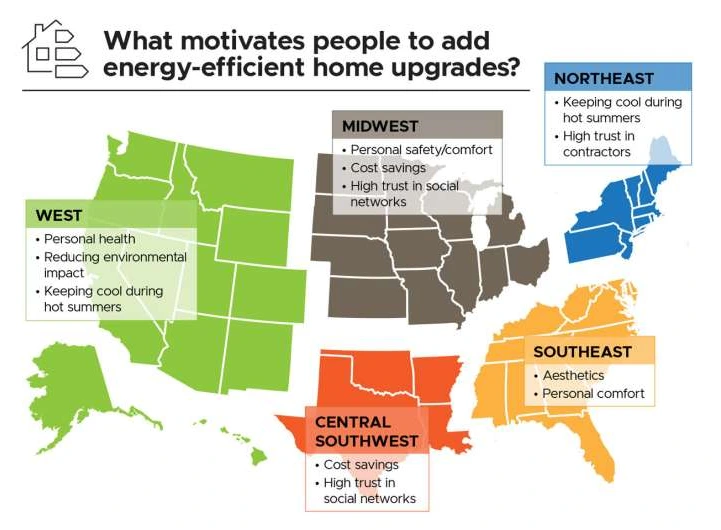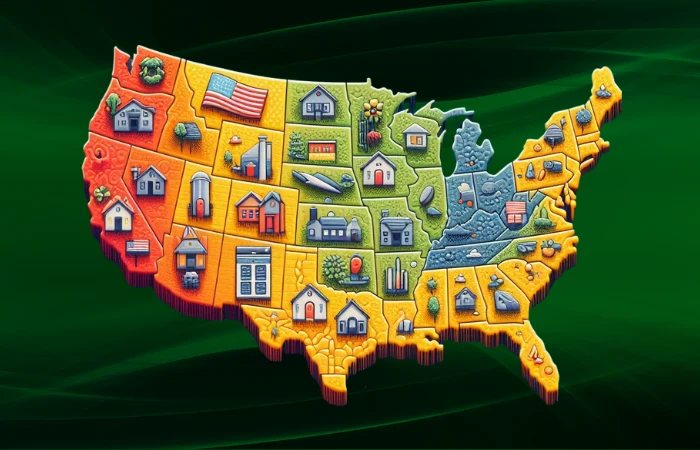The landscape of energy-efficient home upgrades in the United States is as diverse as its geography.
A comprehensive survey by the Pacific Northwest National Laboratory (PNNL) involving over 10,000 participants reveals fascinating regional differences in what drives homeowners to make these changes.
This variation in drive, influenced heavily by geographic location, paints a complex picture of America’s journey towards a greener, more sustainable future.
West: A Focus on Health and Environment
In the West, climate change isn’t just a buzzword but a palpable reality. As temperatures soar, more residents are turning to air conditioning solutions. However, it’s not just comfort driving this change. A deep-seated concern for personal and environmental health is at the forefront.
But there’s more to this trend than seeking comfort. Chrissi Antonopoulos, a residential building analyst at PNNL and the lead author of the study, notes, “We can say with confidence that people in the western United States care about the health impacts, environmental impacts, and the carbon footprint of their home.” This finding emphasizes the region’s growing concern for personal and environmental health.

Specifically, the study reveals a heightened awareness of the carbon emissions associated with cooling options. This region also shows a keen interest in revamping spaces like home offices and kitchens, not just for utility but for a healthier living environment.
Midwest: Cost-Savings and Safety are Key
The Midwest shows a more practical approach, prioritizing personal safety and cost-effectiveness.
Antonopoulos points out the importance of this, stating, “Policymakers in the Midwest should make sure that consumers understand that energy-efficient technology or renovations could make a home more resilient to bad weather or power outages.” This pragmatic concern for economic and physical well-being shapes the energy upgrade decisions in this region.
The survey indicates a strong inclination towards energy-efficient technologies that bolster a home’s resilience against extreme weather and power outages. This practical approach is a cornerstone for policy frameworks in the region, emphasizing the dual benefits of safety and economic efficiency.

Southeast: Aesthetic Appeal and Interior Design Lead the Way
In the Southeast, the visual appeal of homes holds significant weight. Here, energy efficiency intertwines with aesthetics, as homeowners look to enhance their living spaces’ curb appeal and internal beauty. In short, the southeast wants to first make sure all upgrades look good and fit in with the overall design of their home and property.
The study’s findings suggest an inclination towards energy efficiency that aligns with enhancing the visual appeal of living spaces. This perspective is crucial for reaching consumers in this region, intertwining functionality with aesthetics. Collaborations with home builders and contractors could be key, integrating energy-efficient options into broader discussions about home remodeling and design.
Northeast: Trust in Expertise and Efficiency
In the Northeast, the emphasis is on expert guidance and efficient use of space. Homeowners in this region place significant trust in contractors, valuing their expertise in integrating energy-efficient solutions into their homes.
Chrissi Antonopoulos, the study’s lead author, highlights this trust, noting, “People in the Northeast put more trust in contractors.” This reliance on professional advice underscores a preference for informed decisions and quality improvements in home upgrades.
Central Southwest: Community Influence and Social Networks
Contrasting with the Northeast, the Central Southwest shows a strong reliance on community feedback and social networks. Homeowners in this region often turn to their social circles for advice and recommendations on home improvements.
Antonopoulos remarks on this trend, stating, “In the Central Southwest, for example, people tended to place more value on their social networks.” This communal approach reflects a deep-seated trust in shared experiences and word-of-mouth endorsements.
A homeowner in these states (Texas, Oklahoma, Louisiana, and Arkansas) is going to focus on overall cost savings but is going to put emphasis on how the energy-efficient upgrade will be perceived by the community at large and whether any neighbors have already taken the same step.
Understanding the Diverse Landscape of Motivations
Chrissi Antonopoulos points out the gap between aspiring for and adopting energy-efficient technology. By dissecting regional preferences and values, from home comfort to aesthetic enhancements, the research provides vital insights for policy and rebate program design.
Trusted Sources of Information: A Regional Perspective
Interestingly, the survey also sheds light on the trusted sources for information on energy efficiency. While Midwesterners and Central Southwest residents rely more on social networks, Northeasterners place their trust in contractors. This discrepancy underscores the need for targeted communication strategies, perhaps leveraging partnerships with national home improvement retailers and contractors to reach a wider audience effectively.
Looking Ahead: Socioeconomic Factors and Technological Adoption
The PNNL team isn’t stopping here. The next phase involves delving into socioeconomic factors that may influence the adoption of energy-efficient technology.
Antonopoulos emphasizes the importance of moving away from a ‘one-size-fits-all’ approach, advocating for more nuanced strategies that cater to the diverse needs and circumstances of American homeowners.
More To Discover
- Wind Turbines And The Catastrophic Case of Bat Attractions
- How Media’s Single-Use Mask Bias Contributed to PPE Pollution During The Pandemic
- Australia’s Coffee-Concrete: 30% Stronger Pavement With Recycled Coffee Grounds
- Concerns Rise Over Possible Link Between Whale Deaths and Offshore Wind Farms; Facebook Faces Backlash Over Censorship
In summary, this groundbreaking study not only highlights the varied reasons behind energy-efficient home upgrades across the U.S. but also lays a roadmap for future initiatives and policies. It’s a call to action for a more personalized approach in the pursuit of a more energy-efficient and sustainable nation.
Source: Energy Policy




















